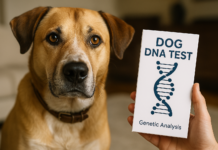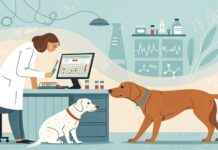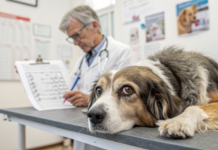Last Updated on April 11, 2023 by Dogs Vets
What Are Spring Hazards for Dogs?
As spring approaches, the weather warms, and flowers bloom, it’s the perfect time for dog owners to enjoy outdoor activities with their furry friends.
However, spring also brings certain hazards that every responsible pet owner should be aware of.
In this comprehensive guide, we will discuss the various spring hazards for dogs and offer some essential safety tips to help you and your canine companion enjoy this beautiful season together.
The Dangers of Spring Allergies
Identifying Allergies in Dogs
Just like humans, dogs can also suffer from seasonal allergies. Common allergens for dogs include pollen, grass, mold, and dust mites. Symptoms of allergies in dogs include:
- Excessive itching or scratching
- Red, irritated skin
- Sneezing or runny nose
- Watery eyes
- Ear infections
If you notice any of these symptoms in your dog, it’s essential to consult with a veterinarian to determine the cause and appropriate treatment.
Preventing and Managing Allergies
To minimize your dog’s exposure to allergens and reduce the severity of allergic reactions, consider the following tips:
- Regular grooming: Keep your dog’s coat clean and free of allergens by brushing them daily and bathing them with a hypoallergenic shampoo.
- Wipe down your dog: After walks or outdoor playtime, use a damp cloth or pet-friendly wipes to remove pollen and other allergens from their fur.
- Limit exposure: On high pollen count days, try to limit your dog’s outdoor activities, especially during peak pollen hours.
- Use air purifiers: Installing air purifiers in your home can help reduce indoor allergens and improve air quality for both you and your pet.
- Consult your veterinarian: If your dog’s allergies are severe, your vet may recommend medication, immunotherapy, or other treatments to help manage their symptoms.
The Threat of Fleas and Ticks
Understanding the Risks of Fleas and Ticks
Fleas and ticks are not only annoying, but they can also transmit diseases to your dog. Fleas can cause skin irritation, hair loss, and even anemia in severe infestations.
Ticks can carry Lyme disease, Rocky Mountain spotted fever, and other harmful illnesses.
Preventing Flea and Tick Infestations
To protect your dog from these pesky parasites, follow these preventive measures:
- Use flea and tick preventatives: Talk to your veterinarian about the best flea and tick prevention products for your dog, such as topical treatments, oral medications, or collars.
- Check your dog regularly: After spending time outdoors, inspect your dog for ticks, especially in areas where ticks like to hide, such as the ears, under the collar, and between the toes.
- Maintain your yard: Keep your grass trimmed and remove any leaf litter, brush, or debris to minimize tick habitats.
- Consider tick repellent landscaping: Planting tick-repellent plants, like lavender, rosemary, or garlic, can help deter ticks from entering your yard.
The Importance of Proper Hydration
Recognizing the Signs of Dehydration
As temperatures rise in spring, it’s crucial to ensure your dog stays hydrated. Signs of dehydration in dogs include:
- Sunken eyes
- Dry, sticky gums
- Lethargy
- Loss of skin elasticity
If you suspect your dog is dehydrated, consult your veterinarian immediately.
Encouraging Adequate Water Intake
To prevent dehydration, follow these tips to ensure your dog drinks enough water:
- Provide clean, fresh water: Ensure your dog has access to clean, fresh water at all times, both indoors and outdoors.
- Bring water on walks: When taking your dog for a walk or hike, carry a portable water bottle and bowl so your dog can drink when needed.
- Use a water fountain: Some dogs may be more inclined to drink from a flowing water source, such as a pet water fountain.
- Offer wet food: If your dog prefers dry kibble, consider incorporating wet food into their diet to increase their overall water intake.
Keeping Your Dog Safe from Toxic Plants
Identifying Poisonous Plants
Spring is a time when plants and flowers bloom, but some of them can be toxic to dogs. Common poisonous plants for dogs include:
- Azaleas
- Daffodils
- Lilies
- Rhododendrons
- Tulips
If you suspect your dog has ingested a toxic plant, contact your veterinarian or a pet poison control center immediately.
Creating a Dog-Friendly Garden
To keep your dog safe from toxic plants, consider the following tips:
- Research plants before planting: Before adding new plants to your garden, research their toxicity to ensure they are safe for your dog.
- Create a designated dog area: Designate a specific area in your yard for your dog to play and explore, away from potentially harmful plants.
- Use barriers: Use fences or plant barriers to keep your dog away from toxic plants in your garden.
- Train your dog: Teach your dog the “leave it” command to discourage them from chewing on plants or other potentially dangerous items.
Steering Clear of Insects
Identifying Harmful Insects for Dogs
Insects can pose a risk to your dog’s health, and it’s essential to know which ones to avoid. Some common harmful insects for dogs include:
- Bees and wasps: Stings from bees and wasps can cause pain, swelling, and even an allergic reaction in some dogs.
- Ants: Bites from certain ant species, such as fire ants, can cause discomfort and localized swelling.
- Mosquitoes: Mosquitoes can transmit heartworms to dogs, which can lead to severe health problems if left untreated.
- Flies: Flies can cause irritation and transmit bacteria, leading to infections.
Protecting Your Dog from Insects
To keep your dog safe from harmful insects, consider these tips:
- Insect repellents: Use pet-safe insect repellents on your dog to deter insects. Consult your veterinarian for recommendations on suitable products.
- Avoid known insect habitats: Steer clear of areas with high insect populations, such as stagnant water or heavily wooded areas.
- Keep your yard clean: Regularly clean up pet waste, and remove any standing water or debris in your yard to minimize insect breeding grounds.
- Screen doors and windows: Install screens on doors and windows to prevent insects from entering your home.
- Heartworm prevention: Ensure your dog is on a heartworm preventative medication, as recommended by your veterinarian, to protect them from heartworms transmitted by mosquitoes.
If your dog is stung or bitten by an insect, monitor them closely for any signs of an allergic reaction or infection. In case of severe reactions or worsening symptoms, consult your veterinarian immediately.
The Benefits of Using a Harness for Your Dog
Advantages of Harnesses Over Collars
Using a harness for your dog can offer several benefits compared to traditional collars, such as:
- Improved control: A harness allows for better control over your dog’s movements, especially for dogs that tend to pull on their leash or are strong and energetic.
- Reduced risk of injury: Harnesses distribute pressure across a larger area of your dog’s body, reducing the risk of injury to the neck, trachea, or spine.
- Minimized choking: A harness reduces the likelihood of choking, as it doesn’t apply pressure to the throat when your dog pulls on the leash.
- Enhanced comfort: Many harnesses come with padding and adjustable straps, ensuring a comfortable and secure fit for your dog.
- Increased visibility: Some harnesses feature reflective materials, making it easier to spot your dog during nighttime walks or in low-light conditions.
Selecting the Right Harness for Your Dog
When choosing a harness for your dog, consider the following factors:
- Size and fit: Measure your dog’s girth and neck circumference to ensure the harness is the correct size. A properly fitted harness should be snug but not too tight, allowing you to fit two fingers between the harness and your dog’s body.
- Style: Harnesses come in various styles, such as back-clip, front-clip, and dual-clip harnesses. Each style has its advantages, depending on your dog’s breed, size, and behavior. For example, front-clip harnesses can be helpful for dogs that pull, while back-clip harnesses are suitable for smaller or well-behaved dogs.
- Material: Look for durable materials that can withstand your dog’s daily activities, such as nylon or leather. Consider harnesses with padding for added comfort.
- Ease of use: Choose a harness that is easy to put on and remove, with adjustable straps for a customized fit.
- Safety features: Reflective materials and additional handles for better control can improve your dog’s safety during walks.
Properly Introducing a Harness to Your Dog
Introducing a harness to your dog may require some patience and positive reinforcement.
Follow these steps to help your dog become comfortable with their new harness:
- Allow your dog to sniff and inspect the harness before putting it on them.
- Use treats and praise to create a positive association with the harness.
- Put the harness on your dog for short periods initially, gradually increasing the duration as your dog becomes more comfortable.
- Practice walking with the harness indoors before venturing outside.
- Be patient and consistent in your training, rewarding your dog for positive behavior while wearing the harness.
Safeguarding Your Dog from Chemicals and Tools
Storing Hazardous Chemicals Safely
Many household chemicals can pose a risk to your dog’s health. To protect your dog, follow these guidelines for storing hazardous chemicals:
- Keep chemicals in their original containers: Always store chemicals in their original containers to avoid confusion and ensure proper labeling.
- Use childproof locks: Install childproof locks on cabinets and storage areas where chemicals are stored to prevent your dog from accessing these hazardous substances.
- Store chemicals out of reach: Keep chemicals on high shelves or in locked cabinets, where your dog cannot reach them.
- Dispose of chemicals safely: Properly dispose of chemicals according to local regulations to avoid accidental ingestion by your dog or other pets in the area.
Recognizing Common Household Chemical Hazards
Some common household chemicals that can be toxic to dogs include:
- Antifreeze
- Bleach
- Cleaning products
- Fertilizers
- Insecticides
- Rodenticides
If you suspect your dog has ingested a harmful chemical, contact your veterinarian or a pet poison control center immediately.
Securing Tools and Equipment
In addition to chemicals, tools and equipment can also pose a threat to your dog’s safety.
To keep your dog safe from potential hazards, follow these precautions:
- Store tools securely: Keep tools and equipment in a locked storage area, such as a garage, shed, or toolbox, to prevent your dog from accessing them.
- Unplug power tools: Always unplug power tools when not in use and store cords out of your dog’s reach.
- Clean up after projects: Promptly clean up any debris or materials, such as nails, screws, or wood splinters, after completing a project to prevent your dog from stepping on or ingesting them.
- Supervise your dog: Monitor your dog closely when working on projects to ensure they do not come into contact with dangerous tools or materials.
By taking these precautions, you can help protect your dog from potential dangers posed by chemicals and tools, ensuring a safe and happy environment for your canine companion.
Recognizing Potential Wildlife Threats
Depending on your location, various wild animals can pose a threat to your dog. Some common wild animals that may be dangerous to dogs include:
- Snakes: Venomous snake bites can be life-threatening to dogs.
- Coyotes: These predators can attack smaller dogs or try to lure larger dogs away to be ambushed by a pack.
- Raccoons: Raccoons can carry diseases, such as rabies, and may become aggressive when threatened.
- Skunks: While skunks are generally not aggressive, they can spray your dog with a foul-smelling liquid if they feel threatened.
- Birds of prey: Large birds, such as eagles or hawks, can potentially target smaller dogs as prey.
Taking Precautions Against Wildlife Encounters
To protect your dog from potential dangers posed by wild animals, consider these tips:
- Keep your dog on a leash: When walking or hiking, keep your dog on a leash to prevent them from chasing or approaching wild animals.
- Stay on designated trails: Stick to well-traveled paths and avoid areas with dense vegetation where wild animals may be hiding.
- Supervise outdoor time: Monitor your dog when they are outside, especially in rural or wooded areas where wild animals are more likely to be present.
- Secure your yard: Install a secure fence around your property to deter wild animals from entering. Remove any potential sources of food, such as pet food or garbage, that may attract wildlife.
- Be aware of your surroundings: Stay alert to any signs of wildlife in your area, such as tracks, droppings, or vocalizations.
What to Do in Case of a Wildlife Encounter
If you encounter a wild animal while with your dog, follow these guidelines to ensure both your safety and your dog’s safety:
- Remain calm: Panicking or making sudden movements can provoke the wild animal.
- Keep your distance: Do not approach or attempt to touch the wild animal, and maintain a safe distance from it.
- Keep your dog close: Keep your dog under control and close to you to prevent any potential conflict.
- Leave the area: Slowly and calmly leave the area, without turning your back on the wild animal, to avoid provoking an attack.
- Report the encounter: If the encounter was with a dangerous or aggressive animal, report it to your local wildlife or animal control authorities.
By staying vigilant and taking precautions, you can minimize the risk of encounters with wild animals and ensure a safe and enjoyable outdoor experience for both you and your dog.
The Risk of Overheating
Recognizing the Signs of Overheating
As the weather gets warmer, it’s essential to be aware of the risk of overheating in dogs. Signs of overheating include:
- Excessive panting
- Rapid heartbeat
- Drooling
- Weakness or collapse
If you suspect your dog is overheating, move them to a cooler area, offer them water, and consult your veterinarian immediately.
Preventing Overheating in Dogs
To protect your dog from overheating, follow these tips:
- Avoid hot surfaces: Be mindful of hot pavement, sand, or other surfaces that can burn your dog’s paws.
- Provide shade: Ensure your dog has access to shaded areas when spending time outdoors.
- Limit exercise during peak heat: Schedule walks and outdoor playtime during cooler parts of the day, such as early morning or late evening.
- Use cooling products: Cooling mats, vests, or bandanas can help keep your dog comfortable during hot weather.
Conclusion
Spring is a wonderful time to enjoy the outdoors with your dog, but it’s important to be aware of potential hazards.
By following these safety tips and staying vigilant, you can help protect your canine companion from seasonal dangers and enjoy a happy, healthy spring together.
Frequently Asked Questions
Q1: Can dogs have seasonal allergies?
A1: Yes, dogs can have seasonal allergies just like humans. Common allergens for dogs include pollen, grass, mold, and dust mites. If you suspect your dog has allergies, consult your veterinarian for diagnosis and treatment.
Q2: How can I protect my dog from fleas and ticks?
A2: To protect your dog from fleas and ticks, use veterinarian-recommended flea and tick prevention products, check your dog regularly for ticks, and maintain your yard to minimize tick habitats.
Q3: How do I know if my dog is dehydrated?
A3: Signs of dehydration in dogs include sunken eyes, dry, sticky gums, lethargy, and loss of skin elasticity. If you suspect your dog is dehydrated, consult your veterinarian immediately.
Q4: What should I do if my dog ingests a toxic plant?
A4: If you suspect your dog has ingested a toxic plant, contact your veterinarian or a pet poison control center immediately. Prompt treatment is crucial to prevent serious complications.
Q5: How can I prevent my dog from overheating in the spring and summer months?
A5: To prevent overheating, avoid hot surfaces that can burn your dog’s paws, provide shade and fresh water, limit exercise during peak heat, and consider using cooling products like mats, vests, or bandanas.
Q6: Are there any specific plants that are more toxic to dogs than others?
A6: Some plants are more toxic to dogs than others, including azaleas, daffodils, lilies, rhododendrons, and tulips. It’s essential to research plants before adding them to your garden or home to ensure they are safe for your dog.
Q7: How can I help my dog with seasonal allergies?
A7: To help your dog with seasonal allergies, consider regular grooming, wiping down your dog after outdoor activities, limiting exposure to allergens, using air purifiers in your home, and consulting your veterinarian for specific treatments or medications.
Fact Check
We hope you enjoyed reading this article. What are your thoughts on the topic?
“At [Dogsvets.com], our goal is to bring you the most accurate and up-to-date information on all things pet-related.
If you have any additional insights or would like to advertise with us, don’t hesitate to get in touch.
If you notice any errors or discrepancies in our content, please let us know so we can correct them.
We welcome your feedback and encourage you to share this article with others.”

















